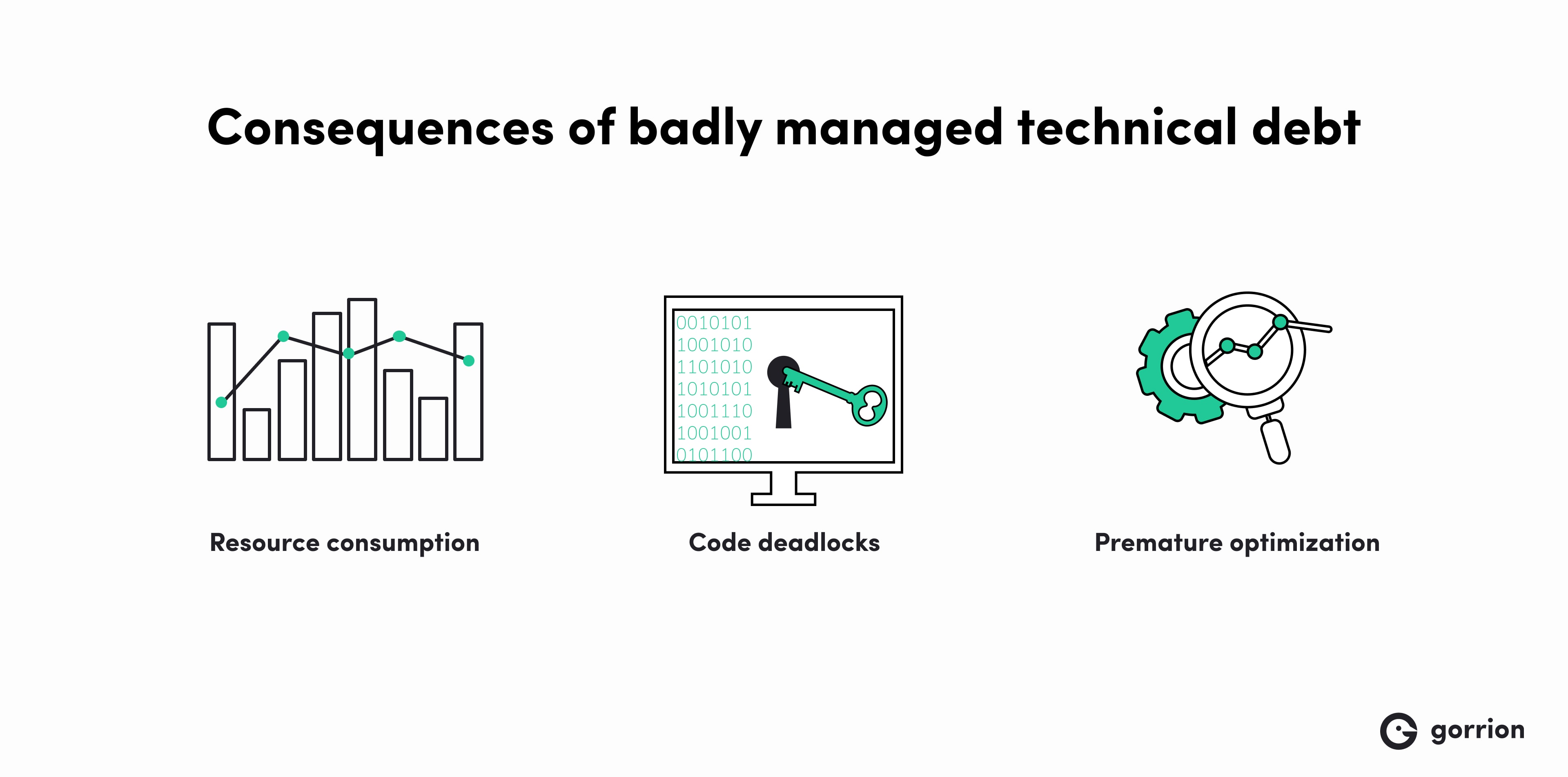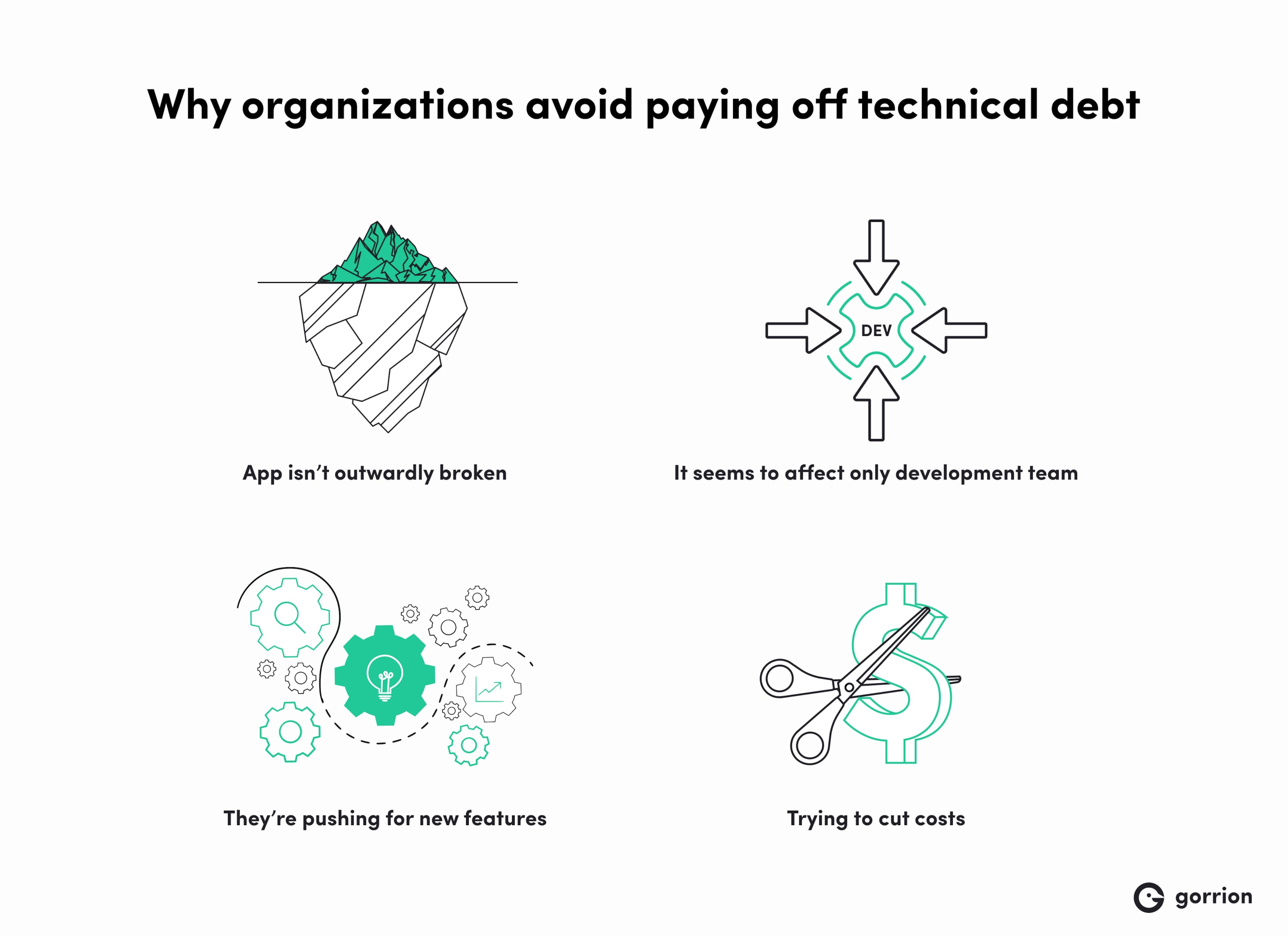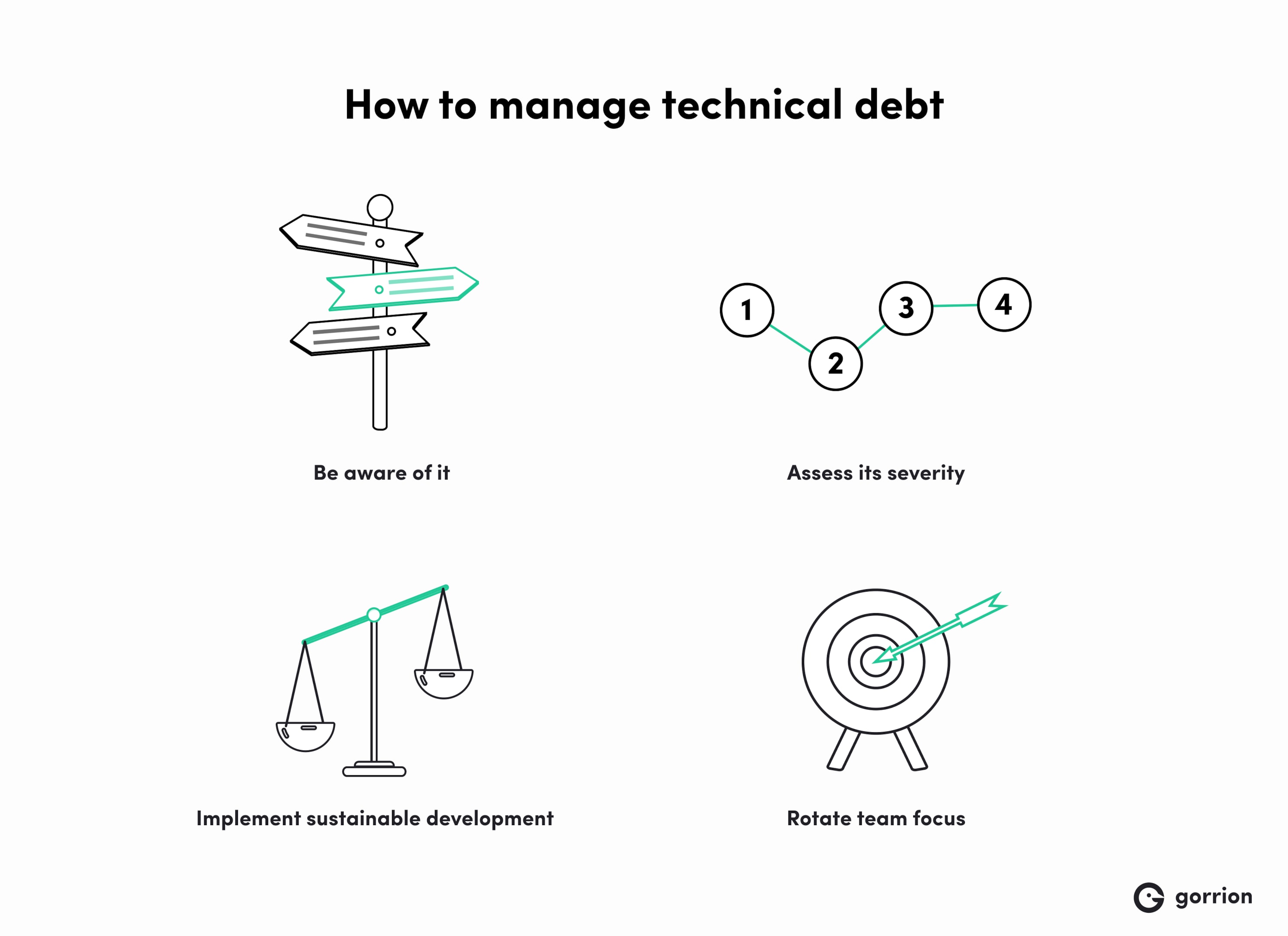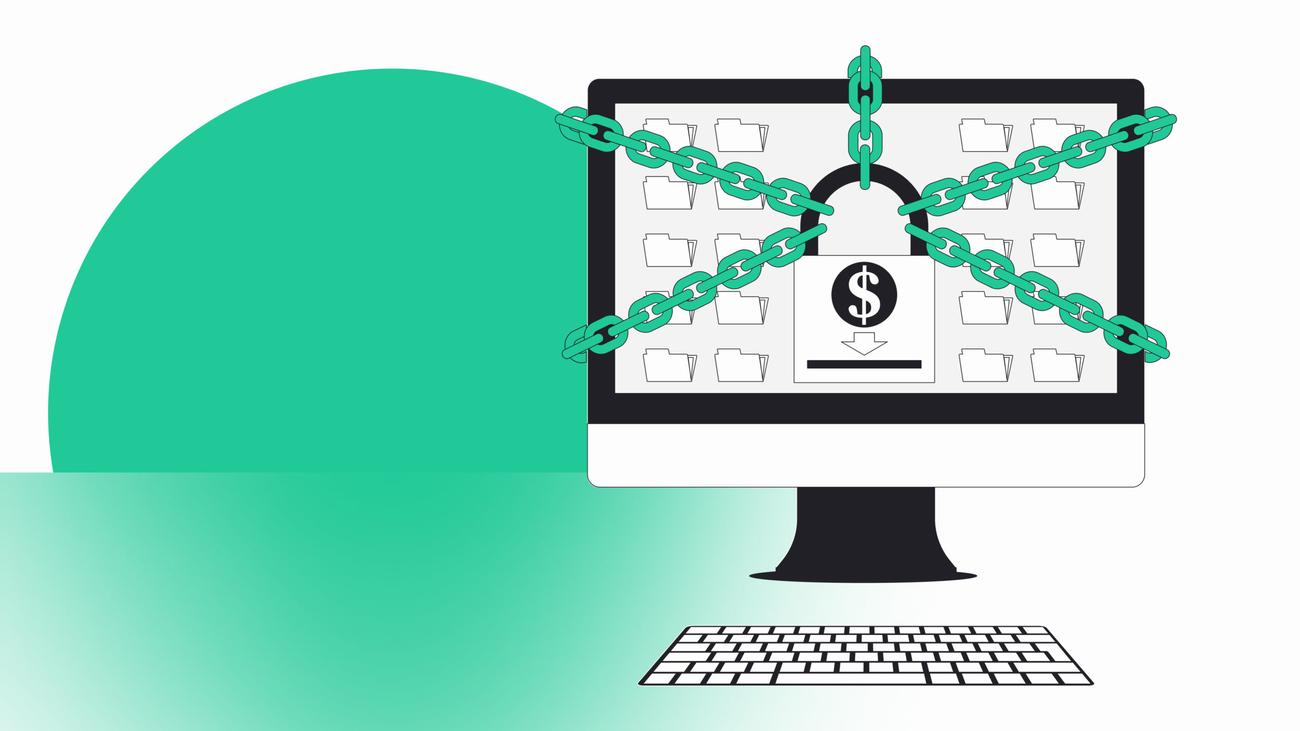

Summary
- Technical debt happens when you make shortcuts and rushed decisions in the code, which builds up to the point where you have to return to it and fix it. It’s like taking a loan, where you borrow time instead of money, and eventually, it needs to be paid back.
- Technical debt isn’t always bad. It can be a strategic tool for growth, especially in scenarios like creating prototypes, MVPs, or adding new features quickly.
- If not managed properly, it can lead to problems like increased resource consumption, deadlock, and premature optimization.
- Effective management involves awareness, assessment, sustainable development processes, and rotational focus.
- In severe cases, a complete refactoring of the software may be necessary.
Many entrepreneurs whose business depends on software development dread the words “technical debt.” They know that it effectively means developers nagging them about fixing “critical” issues (a critical issue being, seemingly, absolutely everything), spending time and money on invisible fixes, and slowing down the release of necessary new features.
Those who don’t dread technical debt, simply don’t know what it is. Yet.
So how come we can so confidently tell you that technical debt isn’t necessarily a bad thing?
Because at Gorrion we know from experience of developing over 200 projects that when you’re managing technical debt in a strategic and informed way, it is the best tool in your growth acceleration toolbox.
This article is a summarized version of our ebook, in which we explain what technical debt is and isn’t, why it’s good and why it can be bad, how to use it strategically and stay on top of it, and finally – how to reduce technical debt when you’re in too deep.
What is technical debt?
Our Chief Innovation Officer, Dominik Guzy, explains technical debt this way:
“Tech debt happens when you make shortcuts and rushed decisions in the code, which builds up to the point where you must return to it.”
Imagine that you can develop a feature in your app in two ways: one is “quick and dirty,” the other one is “proper” (and more time consuming). If you choose the first route, you have just incurred technical debt. The feature will work now, but there’s no guarantee it will work in the future or that it won’t interfere with any further deployments. If it breaks or affects your product in any other way, you will have to fix it, i.e. pay off your debt.
It’s a loan
You may have already picked up on financial lingo and banking metaphors. That was the intention of Ward Cunningham, who coined this term. The easiest way to think of technical debt and to manage it is by looking at it as if it were financial debt.
Yes, many people will say “all debt is bad,” but even more will say it’s a great way to leverage yourself, and some will say it’s the only way to dig themselves out of a hole. Everyone knows debts must be paid off and everyone understands that they come with an interest. We can probably also all agree that taking more debt to pay off a previous debt is a bad idea and must be avoided at all cost. All these things are true both when we speak of money and when we speak of code. The difference is, with technical debt you’re effectively borrowing time and not money itself.
It’s not a surety bond
Without going into philosophical debates, it’s important to note what technical debt is not. Technical debt is not simply “poor code quality.”
It’s a different thing when developers consciously make short term sacrifices, take shortcuts, or find workarounds due to project constraints, but they are aware of the consequences and intend to fix their code in the future. Imagine your app going down due to a critical error that must be fixed immediately by any means necessary so that the software can be operational again. The fix is dirty, but it works for now. You’ve just taken a loan to stay afloat.
It’s an entirely different thing when developers don’t know (or don’t care) what they’re doing, but they’re doing it anyway. Imagine you hire a team of unskilled developers who don’t have experience in your field or technology of choice, and they just trudge ahead creating shoddy software that looks like it’s working for now. That’s not a loan – you’ve just signed a surety bond for a very unreliable debtor and there will come a time that you have to pay it, whether you like it or not.
We mention this because, historically, Gorrion has occasionally taken over projects where this happened. The code quality was so bad that it was no longer feasible to add new features without performing near-impossible “circus tricks” that would take a whole lot of unnecessary time and money. There was nothing else to do, but to rewrite the code from scratch. In instances such as these, it’s difficult to speak of “technical debt” and not a “botched job.”
When is technical debt good?
Now that we’re all on the same page as to what technical debt is, we can finally answer this seemingly rhetorical question: can technical debt be good?
And we at Gorrion say: yes, it very much can! There are instances where you’d want to welcome it as a friend. This is especially true for projects where you need to prioritize speed over quality.

Throwaway prototypes
You create a prototype or a proof of concept (POC) to find a solution that simply shows a problem can be solved – nothing less, nothing more. It doesn’t need the best performance, well-architected code, or massive test code coverage.
The idea behind prototypes and PoCs is that they should be as fast and as inexpensive as possible. They make for a very basic scaffolding to the final product so if you have to knock them down and start again, there’s very little harm done.
Technical debt in throwaway prototypes is like taking a loan with no interest payments – doesn’t really cost you a thing (as long as you pay it off on time) but it’s a quick way to get what you want.
MVPs
Then we have the case of startups and minimum viable products (MVPs). The situation here is somewhat similar: an MVP is meant to prove something (i.e. market demand) and, as the name suggests, it provides the bare minimum.
Oftentimes coming up with an MVP requires some shortcuts. This can either be because of scarce resources – a gripe startups only know so well! – or time pressure. In any case, tech debt here is like a mortgage. It’s frequently a “necessary evil” to get things going and a long-term burden, however – if taken responsibly and paid off wisely – it’s a great leverage for a lifetime investment.
New features
Not only new businesses are allowed to go into hock, though! Even mature organizations can – and perhaps even should – run up some technical debt in certain situations.
Imagine you have a mature product, but you’re looking into new niches or business opportunities. There’s already some traction there, perhaps even some competition, so speed is critical – to be successful, you need to be the first to the market. However, you don’t really want to put all of your chips on the table – you don’t know if there will be any interest in this new feature of yours or you’re not sure this market is really right for you.
In this case, even though you have a mature product, you treat the new feature very much like an MVP. In order to maintain speed and validate your idea quickly, you use technical debt as a leverage. If it pays off – great, if it doesn’t – no harm done!
When and why is technical debt bad?
If technical debt is so good then why does it get such a bad rep? Why isn’t everybody talking about it?
Perhaps you should think of it the other way round. Everyone has at least some degree of technical debt. The question is how much technical debt is too much? And when is it OK? Technical debt has become a sad reality of all software development, unavoidable in all projects due to pressures from the business, inadequate resources, and other factors. Companies will simply push for new features to generate more revenue or they will “optimize” resources to squeeze out more from the revenue they already have. Engineers are then forced to find shortcuts to deliver on these expectations.
It’s therefore important for businesses to understand what happens if their technical debt accumulates and how that affects not just the code quality, not just the product, but the business as a whole.

The consequences
Resource consumption
First and foremost, paying off tech debt takes time and resources. After all, if the right solution was the easiest and the quickest to develop, it would have been implemented from the start. Trey Huffine even defined technical debt as “any code added now that will take more work to fix at a later time.” Going back to fix things requires the team to take a step back, which will slow down or even halt new development entirely. In any case, it’s sure to affect the software development lifecycle.
From a business operations perspective, it’s important to remember you’re slowing down so that you can speed up later. We see this regularly – clients are hesitant to allocate time to fixes, prioritize maintenance over software development efforts, do any work that doesn’t show anything new. This is a shortsighted mistake. While it does take time and resources to address technical debt, this will provide returns in easier time for developers, better product, and more growth opportunities in the future. Not to mention consequences of neglecting technical debt, which are far worse and more symptomatic than temporary slowdowns.
Deadlock
As we’ve mentioned before, all debts must be paid. With technical debt, if you don’t do it yourself, your code will do it for you. If left unattended, tech debt builds up to a point where it causes deadlock.
A “deadlock” is a technical term for when two (or more) processes are running but neither is able to finish because they need more resources that are blocked by the other process. This creates an endless, unsolvable loop.
At this point technical debt is not just a problem for the development team, it’s a problem for business operations as well, as the application can’t grow anymore and it may in fact slow down, show an increased number of bugs, or shut down altogether.
Premature optimization
It may seem incredulous but technical debt can be a problem even when there isn’t any technical debt. This is called premature optimization and it occurs when the code is optimized too early, when priorities are misplaced, or when complexity and abstractions are addressed over necessities.
Premature optimization isn’t necessarily a problem for the development team. In fact, some particularly opinionated developers argue that all tech debt is bad and “no debt” should be the default state. However, it’s a huge problem for the business. It means that resources were poorly allocated (and therefore lost), priorities weren’t communicated clearly, and the company lost profit and/or opportunities as a consequence.
Why it’s so hard to pay off
We’ve already mentioned the struggle we sometimes experience personally when working with clients that is, frankly, prevalent in software development everywhere – the resistance from business stakeholders. Let’s face it, to non-technical people technical debt is much less visible than actual financial debt that they know and understand could sink their company. And technical teams demanding technical debt be paid off look far less threatening than creditors and debt collectors. And so, technical debt is deprioritized despite being as dangerous as (if not more dangerous than) financial debt.
From our experience, these are some of the most common “blinkers” businesses wear when it comes to identifying technical debt.

“Don’t fix what ain’t broken”
If the software is working, surely it means everything’s ok with code quality as well, right…? Well, wrong.
Businesses are often ignorant about existing or potential issues with their product simply because of a poor understanding of the more technical aspects. And, admittedly, it is hard to be worried about things we can’t see and/or understand, like climate change and technical debt. So, following the old adage of “don’t fix what ain’t broken,” they aren’t really invested in improving code quality unless it is actually necessary (i.e. the app breaks).
That’s a you problem
So we’ve established that business stakeholders rarely understand what will happen if they don’t address technical debt, but it’s equally important to point out they are also rarely affected by it. Conversely, developers both understand it very well and find it significantly more painful. Code that’s not optimized is harder to maintain and to integrate, resulting in more workload and harder times for developers.
Without certain “empathy” for their work (or at least for how their wages affect the payroll) it’s hard to agree what goals to tackle next and to prioritize things that would make that workload easier, even if – ultimately – it’s for the benefit of the entire business.
Fictitious force
Let’s face it, “we’ve developed this new thing” will always sound more appealing to business leaders than “we’ve fixed this old thing you didn’t know was broken.” That’s somewhat understandable, because new features mean new opportunities to sell, and this means more revenue and more opportunities to grow. Which is why, when the product starts to get some traction on the market, it’s very hard for the business to slow down (much less stop altogether!) and potentially disturb that growing trend. This “fictitious force” that drives business leaders and the willingness to please them that motivates other stakeholders leads them to neglect technical debt in pursuit of novelty.
Cutting costs
Finally, there’s an old Polish saying that goes something like this: if you don’t know what the motive is then the motive is always money. So if you don’t know why businesses don’t eliminate technical debt, it’s simply because it’s cheaper that way. After all, as we’ve already established, fixing issues takes a significant amount of time and effort and affects progress along the way.
There’s a flipside to this type of thinking, though, because all is fine and well as long as the code is still functional. However, without tackling technical debt, at some point it won’t be so fine, and you will need to refactor the entire application. That, our friend, is not at all cheaper… to say the least.
How to manage technical debt – the right way
So too little debt is bad and too much debt is bad, and technical debt can be both good and disastrous… If we’ve learned anything from this ebook, it’s this: moderation in all things.
So how should you manage your technical debt so that it works in your favor and not against you? There are 4 strategies that you should consider: awareness (tracking technical debt), assessment (identifying technical debt), sustainable software development processes, and rotational focus. We discuss them in more detail in our free technical debt ebook.

And if all else fails…?
If you’re reading this because you already have an existing product and are struggling to reduce technical debt, you need to face the possibility that you’re in too deep. Sometimes, the strategies from our ebook work, but other times, there’s nothing else to do but to perform a complete refactoring of the software. The sooner, the better.
If you suspect this might be the case and you don’t know how to approach this problem, we can help. We’ve worked with multiple products that seemed like they’re beyond repair when they first arrived on our doorstep, and yet they are now operational and successful. Let’s see if we can help you, too!


Have a project in mind?
Let’s meet - book a free consultation and we’ll get back to you within 24 hrs.
At Gorrion, Dominika Stankiewicz manages content. Having spent a decade in marketing and communications, she’s the master of the written word and the guardian of style. On our blog she shares her experience in B2B product marketing to help SaaS companies plan and execute their go-to-market strategy. In her spare time, she reviews manuscripts for publishers and bakes cakes. She loves cats, books, and American football.



